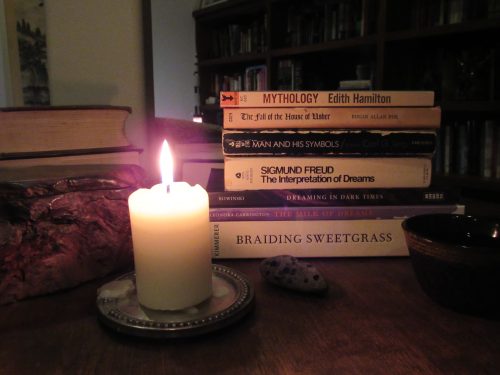
Many adults dream less as they get older, and they miss it. They miss the pleasantly curious feeling of waking up with an alluring new message from the unconscious in their minds. A drastic drop in dreaming is not, however, an inevitable feature of aging. People can continue having vibrant, inspiring dreams all through their lives if they follow a few simple practices.
The typical trajectory of dreaming through the life cycle starts with the highest levels of dream recall in childhood and adolescence, and usually diminishes in the later stages of adulthood. According to a 2018 survey of 5,255 American adults on their attitudes towards dreams (available in the Sleep and Dream Database), 57% of men between 18 and 34 years of age remember at least one dream a week. For men between 35 and 54 the figure is 50%, and for men 55 and older it’s 45%. For women, recall is even higher in early life, with 60% between 18 and 34 remembering at least one dream a week, then the drop-off is sharper, with a figure of 53% for women between 35 and 54, and 41% for women 55 and older.
For both men and women, the percentage of people who say they rarely or never remember their dreams increases with age. With men, 27% of 18-34 year olds have little or no dream recall, but that rises to 30% for men between 35 and 54, and 36% for men 55 and older. With women, little or no dream recall is reported by 23% of 18-34 year olds, 28% for women between 35 and 54, and 36% for women 55 and older. It’s also important to note that many older people still have very frequent dream recall: 7% of men and 8% of women age 55 and older remember a dream nearly every morning.
These survey findings indicate that age is not destiny with your powers of dreaming. If you follow the four simple practices below, you will be able to remember more of your dreams and discover new ways of bringing their creative energies into your waking life, no matter what your age.
- Wake up slowly. When we are asleep and dreaming, our brains operate in a distinctive mode that’s different from normal waking consciousness. If you wake up too abruptly (for instance, to a loud alarm clock), your mind does not have enough time to transfer your experiences from the dreaming mode into the waking mode. So try this: when you wake up, either after a long night’s rest or an afternoon nap, give yourself a few calm moments to make the sleep-wake transition. Try not to jump out of bed, turn on the light, or check your phone for at least a minute or two, so the dreams you were just experiencing have a better chance of crossing the memory threshold into your waking awareness.
- Keep a dream journal. Even the most vivid dreams can fade soon after waking. If you place a pad of paper and a pen or pencil by your bedside, you can record your dreams quickly and conveniently. Voice-to-text apps can also work well for dream recording, but they have the downside of relying on a phone, with its many distracting features. Keeping a dream journal has at least two big benefits. One it enables you to preserve your dreams over time so you can study them for meaningful patterns. Two, it invites new dreams by making it easier for them to enter into the waking world.
- Share your dreams with others. One of the most natural forms of human communication is dream-sharing. Throughout history, in cultures all over the world, people have made a regular practice of sharing and discussing their dreams with family, friends, and members of their community. Sharing dreams can provide unique opportunities for developing more empathetic understanding between different people, with more emotional honesty and authentic self-expression. Talking about dreams with people who are important to you will deepen your relationships with them, and further stimulate your recall capacities.
- Welcome visitation dreams. The one exception to the age-related decline of dreaming is the experience of visitation dreams, in which someone who has died appears as if alive again in a dream. All other typical dreams (flying, falling, being chased, sexuality) tend to diminish through the life span, but visitation dreams become more frequent later in life. This makes sense, because older people are more likely than younger people to have close friends and family members who have died, and who can thus appear in these kinds of dreams. Although strange and uncanny, visitation dreams often bring positive feelings of reassurance and consolation to the dreamers regarding the death of their loved ones. Even if it remains uncertain where these otherworldly dreams ultimately come from (is it a ghost? A spirit? An image from the unconscious?), their emotional benefits make them among the most meaningful types of dreams people experience in the latter years of life.
Note: this post first appeared in Psychology Today, March 15, 2022.

 An outbreak of war and violent conflict is very likely to prompt a wave of nightmares of traumatic experiences, mournful losses, and threat simulations. This seems to be part of our internal crisis-response system when the external world descends into chaos and bloodshed, and our minds struggle to make sense of what is happening and find a way to survive the dangers.
An outbreak of war and violent conflict is very likely to prompt a wave of nightmares of traumatic experiences, mournful losses, and threat simulations. This seems to be part of our internal crisis-response system when the external world descends into chaos and bloodshed, and our minds struggle to make sense of what is happening and find a way to survive the dangers. This has been a rough season for fans of the Portland Trailblazers basketball team. The players are learning a new system from their rookie head coach, Chauncey Billups, in his first season in that role. Their star player, Damien Lillard, plays poorly (by his standards) at the outset, then is forced to undergo season-ending surgery. Three other players in the original rotation—Cody Zeller, Larry Nance Jr., and Nassir Little—go down with injuries. The General Manager of the team, Neil Olshey, is summarily fired after years of internal conflict, leaving the operations in the hands of neophyte executives and detached ownership. Just before the trade deadline they deal away three of their best remaining players—Norman Powell, Robert Covington, Jr., and the beloved C.J. McCollum. In return the Blazers receive some promising guys (Josh Hart, Justice Winslow, Keon Johnson), plus draft picks and salary cap flexibility (an aspect of the game I don’t understand and don’t want to understand). In the midst of it all, the team wins a few surprising games, but loses many more, often by huge margins. Now, with a season-ending injury to Jusuf Nurkic, the lone remainder from the starting line-up at the beginning of the season, the Blazers have been reduced to a fragment of what they hoped to become this year.
This has been a rough season for fans of the Portland Trailblazers basketball team. The players are learning a new system from their rookie head coach, Chauncey Billups, in his first season in that role. Their star player, Damien Lillard, plays poorly (by his standards) at the outset, then is forced to undergo season-ending surgery. Three other players in the original rotation—Cody Zeller, Larry Nance Jr., and Nassir Little—go down with injuries. The General Manager of the team, Neil Olshey, is summarily fired after years of internal conflict, leaving the operations in the hands of neophyte executives and detached ownership. Just before the trade deadline they deal away three of their best remaining players—Norman Powell, Robert Covington, Jr., and the beloved C.J. McCollum. In return the Blazers receive some promising guys (Josh Hart, Justice Winslow, Keon Johnson), plus draft picks and salary cap flexibility (an aspect of the game I don’t understand and don’t want to understand). In the midst of it all, the team wins a few surprising games, but loses many more, often by huge margins. Now, with a season-ending injury to Jusuf Nurkic, the lone remainder from the starting line-up at the beginning of the season, the Blazers have been reduced to a fragment of what they hoped to become this year. A Dream Library is a playground for studying and dreaming: for studying while dreaming, and dreaming while studying. It’s a spatial technology for stimulating your oneiric imagination. It’s not a shrine to dreaming, but it’s not not a shrine to dreaming, either. It’s your personally crafted portal into the intuitive depths of your own mind.
A Dream Library is a playground for studying and dreaming: for studying while dreaming, and dreaming while studying. It’s a spatial technology for stimulating your oneiric imagination. It’s not a shrine to dreaming, but it’s not not a shrine to dreaming, either. It’s your personally crafted portal into the intuitive depths of your own mind. Of SUVs, prosperous males, and watching witches.
Of SUVs, prosperous males, and watching witches. As a dream researcher, I try to promote public interest in dreaming and its many exciting possibilities. And yet also as a dream researcher, I try to highlight potential problems and misleading claims that can do more public harm than good. This creates a dilemma with the topic of lucid dreaming, which is increasingly popular and yet has pitfalls and drawbacks that its advocates rarely mention or even seem to know exist.
As a dream researcher, I try to promote public interest in dreaming and its many exciting possibilities. And yet also as a dream researcher, I try to highlight potential problems and misleading claims that can do more public harm than good. This creates a dilemma with the topic of lucid dreaming, which is increasingly popular and yet has pitfalls and drawbacks that its advocates rarely mention or even seem to know exist.